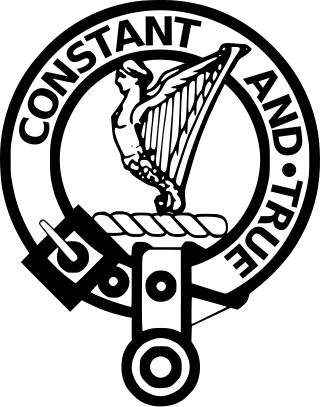
Earl of Elgin is a title in the Peerage of Scotland, created in 1633 for Thomas Bruce, 3rd Lord Kinloss. He was later created Baron Bruce, of Whorlton in the County of York, in the Peerage of England on 30 July 1641. The Earl of Elgin is the hereditary Clan Chief of Clan Bruce.

Baron Willoughby de Eresby is a title in the Peerage of England. It was created in 1313 for Robert de Willoughby. Since 1983, the title has been held by Jane Heathcote-Drummond-Willoughby, 28th Baroness Willoughby de Eresby.

Baron Macdonald, of Slate in the County of Antrim, is a title in the Peerage of Ireland. It was created in 1776 for Sir Alexander Macdonald, 9th Baronet, of Sleat. The Macdonald family of Sleat descends from Uisdean Macdonald, also known as Hugh of Sleat, or Hugh Macdonald, who was an illegitimate son of Alexander Macdonald, Earl of Ross. On 28 May 1625, his great-great-great-great-grandson Donald Gorm Og Macdonald was created a baronet, of Sleat in the Isle of Skye in the County of Inverness, in the Baronetage of Nova Scotia. The baronetcy was created with remainder to heirs male whatsoever and with a special clause of precedence which provided that it should have precedency over all former baronets.

Clan Rose is a Scottish clan of the Scottish Highlands.

Kilravock Castle is located near the village of Croy, between Inverness and Nairn, in the council area of Highland, Scotland. It was begun around 1460 and has been the seat of the Clan Rose since that time. The castle is a composite of a 15th-century tower house and several later additions. The original name for the castle was Cill Rathaig; Scottish Gaelic meaning "church at the small circular fort".
Alexander Duff, 3rd Earl Fife was a Scottish nobleman.

Thomas John Hamilton FitzMaurice, 5th Earl of Orkney was a Scottish aristocrat.

William Duff, 1st Earl Fife, of Braco, Banff, was a Scottish landowner and politician who sat in the House of Commons from 1727 to 1734.
James Stuart, 4th Earl of Moray was a Scottish nobleman and landowner.

There have been four baronetcies created for persons with the surname Hope, three in the Baronetage of Nova Scotia and one in the Baronetage of the United Kingdom. As of 2010 one creation is extant, one dormant and two extinct.

Sir Andrew Agnew, 8th Baronet DL was a Scottish politician and baronet.
There have been three baronetcies created for people with the surname Moncreiffe or Moncreiff, two in the Baronetage of Nova Scotia and one in the Baronetage of the United Kingdom. Two of the titles are dormant, as the heir has not proved his descent, and one is extant, though its holder does not bear the surname of Moncreiffe.
The Sheriff of Ross, Cromarty and Sutherland was historically responsible for enforcing law and order in Ross-shire, Cromartyshire and Sutherland in Scotland.

Baron of Muirton is a title of nobility in the Baronage of Scotland.

Hugh Rose, 15th Baron of Kilravock and Chief of Clan Rose, (1663–1732) was one of the Scottish representatives to the first Parliament of Great Britain as MP for Nairnshire.

Hugh Rose, 16th Baron of Kilravock (1684-1755) was a Member of Parliament for Ross-shire and Chief of Clan Rose. The eldest son of Hugh Rose, 15th of Kilravock, he inherited his father's estates and the Clan Chiefdom on his father's death in 1732.

Hugh Rose, 20th Baron of Kilravock (1781–1827), was a Member of Parliament for Nairnshire and the Chief of Clan Rose. He was the eldest son of Hugh Rose of Brea and Broadley and his wife Elizabeth Rose, Lady of Kilravock. Upon his mother's death in 1815, he inherited her estates and became the Clan Chief of the Roses.

Sir William Rose was a British barrister and civil servant who served as Clerk of the Parliaments from 1875 to 1885, succeeding his father.

Major James Rose, 23rd Baron of Kilravock (1820-1909) was a British Army officer serving in British India, the Lord Lieutenant of Nairn and the Chief of Clan Rose. The third surviving son of Hugh Rose, 20th of Kilravock by his second wife, Catherine Mackintosh of Farr.

Lt Col Hugh Rose, 24th Baron of Kilravock (1863–1946) was a decorated British Army officer serving in the Black Watch, rising to become Lieutenant Colonel of the 1st Battalion, Black Watch. Rose was also the Chief of Clan Rose and a Deputy Lieutenant and Justice of the Peace of the County of Nairn.













